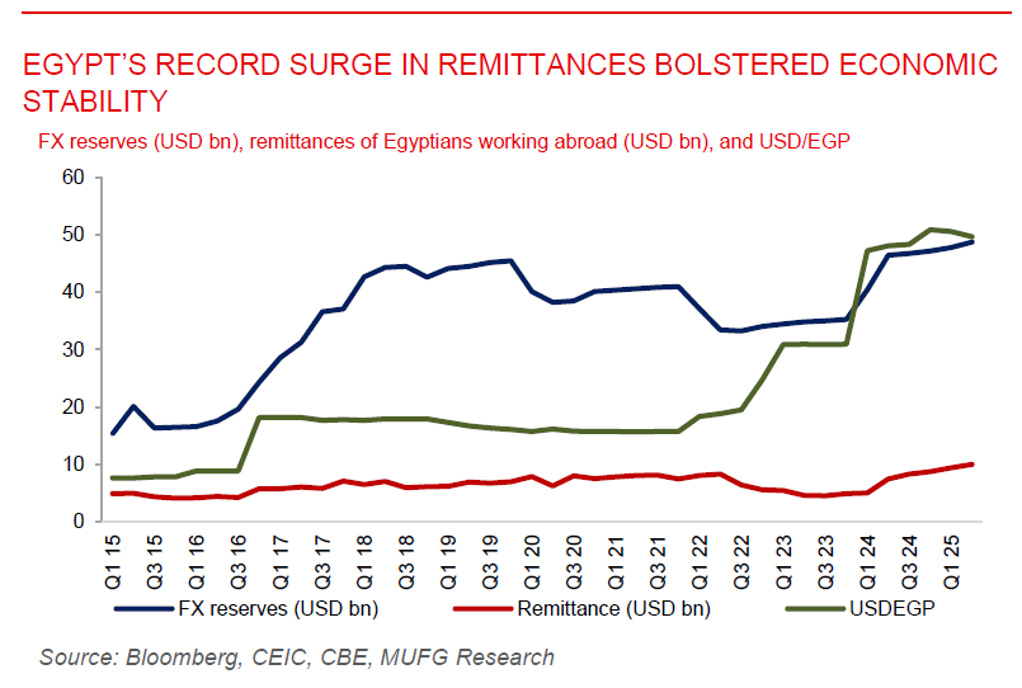To read the full report, please download the PDF above.
Middle East Daily
SOOJIN KIM
Research Analyst
DIFC Branch – Dubai
T: +44(4)387 5031
E: soojin.kim@ae.mufg.jp
MUFG Bank, Ltd. and MUFG Securities plc
A member of MUFG, a global financial group
Middle East Daily
COMMODITIES / ENERGY
Oil steadies ahead of tariffs on India’s Russian crude import. Oil prices stabilised after a sharp drop as investors awaited the imposition of higher US tariffs on Indian imports tied to Russian crude purchases, with little sign of any shift in India’s buying patterns. Brent hovered near USD67/b and WTI above USD63/b, after both benchmarks fell more than 2% in the previous session. Starting today, the US will double levies on some Indian goods to 50% in retaliation for the country’s continued intake of Russia’s oil, though Indian refiners reportedly plan to maintain flows of around 1.4-1.6mb/d for October and beyond, only slightly below the first-half average of 1.8 million. While US industry data showed crude stockpiles fell modestly by 1 million barrels last week, near-term supply tightness was reflected in Brent’s prompt spread holding in backwardation, even as long-term contracts remain in contango, highlighting expectations of a glut in 2025 as OPEC+ adds supply. Looking ahead, the market remains caught between short-term signals of tightness and long-term bearish pressures from oversupply and US trade policy risks, with price direction hinging on the impact of tariffs and progress in Ukraine ceasefire efforts.
Gold holds firm amid Fed independence concerns. Gold traded above USD3,390/oz, holding recent gains after President Trump escalated efforts to oust Fed Governor Lisa Cook, raising fears over central bank independence. Markets remain focused on whether Chair Powell will cut rates next month, with worries that early easing could fuel inflation, a dynamic supportive for haven demand. Gold, already up more than 25% this year, has consolidated after peaking above USD3,500/oz, and investors now await US personal consumption data Friday for further policy cues.
MIDDLE EAST - CREDIT TRADING
End of day comment – 26 August 2025. Slightly weaker day overall. Volumes picked up but are still running around 50% of a normal pre summer trading day. Morning flows were balanced but the afternoon saw flows tilting towards selling. The steepening of the UST curve had the opposite effect on spreads. The shorter end bonds in IG were rather sticky in price/yield and closed +3/5bp whilst the long end +1/2bp. QATAR long end remains most active in IG with 50s closing -0.375pt/+1bp. ADGB overall lacked activity. Quasi sovereign bonds underperformed sovereign today, seen a mix of ETF and RM selling. In AD names mainly ADNOCM/ADQABU was sold, ADQABU 35s closed -0.25pt/+4bp. In QA names QPETRO saw some selling, 41s closing -0.375pt/+3bp. Financials continue to be very sticky in price terms, seen some retail demand in 5y bonds, spreads again though moving with UST moves, so on average bonds are 3/4bp wider. Corp bonds trade very technical, DPWDU saw 49s squeeze today (+0.5pt/-7bp) but belly bonds were offered. ALDAR starting to see some sellers 35s closing -0.125pt/+3bp. On the primary side Saudi banks are the first to come with Saudi Fransi launching a T2 1bn USD deal 10NC% at T+200bp. Overall it feels like some macro risks are reappearing. FED independence concerns, France/UK debt sustainability to name some rates relevant ones. What it seems to do is bringing some RM selling out. So far though the market is more than willing to take bonds down leading to rather gradual moves wider.
MIDDLE EAST - MACRO / MARKETS
Egypt’s record surge in remittances bolstered economic stability. Egypt recorded a historic surge in remittances during FY 2024/2025, with inflows reaching USD36.5bn, a 66% increase compare to the previous year. The Central Bank of Egypt (CBE) highlighted that June alone saw an unprecedented USD3.6bn, marking the highest monthly inflow on record. This sharp rise underscores the resilience and confidence of Egyptians abroad in supporting the domestic economy, even amid ongoing financial challenges. Remittances remain a crucial source of foreign currency for Egypt, helping to bolster external reserves, ease pressure on the balance of payments, and stabilise the exchange rate. Going forward, sustaining this momentum will be essential in mitigating external vulnerabilities and providing a buffer for the country’s broader economic reform agenda.
WEF highlights fintech as driver of next-generation financial inclusion in MENA. According to the World Economic Forum’s recent report, MENA is undergoing a rapid financial transformation powered by digital communication platforms. The study highlights that fintech net revenues in the region are expected to grow at 35% annually through 2028, more than double the global average. It also estimates that full digital integration could raise GDP per capita by up to 46% over the next 30 years, generating nearly USD300bn in added value in the first year alone. The findings emphasise how AI-driven ecosystems and cross-border partnerships are reshaping financial inclusion, enhancing productivity, and positioning MENA as a hub for digital financial innovation.

